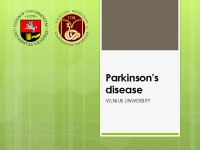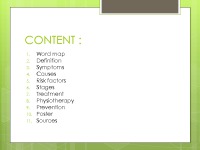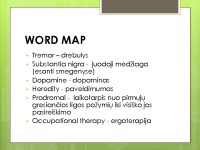Parkinson's Disease Slides



Parkinson's disease. Content. Word map. Definition. Symptoms. Causes. Risk factors. Stages of parkinson’s disease. Treatment. Medications. Physiotherapy. Prevention. Whole Body Vibration Versus Conventional Physiotherapy to Improve Balance and Gait in Parkinson’s Disease. Sources. Video.
Word map Definition Symptoms Causes Risk factors Stages Treatment Physiotherapy Prevention Poster Sources.
Tremor – drebulys Substantia nigra - juodoji medžiaga (esanti smegenyse) Dopamine - dopaminas Heredity - paveldimumas Prodromal - laikotarpis nuo pirmųjų gresiančios ligos požymių iki visiško jos pasireiškimo Occupational therapy - ergoterapija.
Parkinson's disease (PD) is a long-term degenerative disorder of the central nervous system that mainly affects the motor system.
Involuntary shaking of particular parts of the body (tremor) Slow movement Stiff and inflexible muscles Balance problems – this may increase the chance of a fall Sleeping problems (insomnia) Depression and anxiety Increased sweating Memory problems Weight loss.
Parkinson's disease is caused by a loss of nerve cells in part of the brain called the substantia nigra. This leads to a reduction in a chemical called dopamine in the brain.
Supportive treatments – such as physiotherapy, occupational therapy Deep brain stimulation Medication.
Drugs that increase the level of dopamine in the brain Drugs that affect other brain chemicals in the body Drugs that help control nonmotor symptoms.
- Medicine Presentations
- MS PowerPoint 1835 KB
- 2020 m.
- English
- 18 pages (456 words)
- University
- Karolina

















